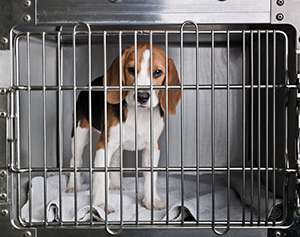2021 sees drop in Irish animal tests, but will progress be sustained in future years?
The Irish government’s Health Products Regulatory Authority (HPRA) has just released its statistical report for animal experiments in Ireland for the year 2021.
The IAVS is grateful for the small mercy of an 11% reduction in animal tests compared with 2020, with 15,760 less animals being painfully sacrificed in Irish labs. However, the death toll of over 121,000 animals is still a bloody stain on Ireland’s reputation. Once again, most of these killings – about 82,000 - are due to extremely cruel poisoning tests of botox-type products (Botulinum toxin – Bt), which the HPRA misleading describes as ‘medicinal’ products, even though a significant proportion of these batches are destined for cosmetic use.
Batches of Bt are tested on mice in the so-called Lethal Dose 50 test. Different dosages of the substance are injected into the abdomen of groups of mice to determine the amount at which half of the animals die. Since the poison paralyzes the respiratory muscles, many of the mice die of suffocation while fully conscious. Despite one botox company, Allergan, developing a non-animal testing method almost a decade ago, the HPRA continues to allow other companies to conduct the animal tests even though, with a little effort, the non-animal method could be adapted to all brands of Bt.
The IAVS is also disturbed by the large increase of 29% in the number of animals – up to 13,445 in 2021 - used in ‘basic research’, which refers to experiments with no direct practical value that aim to generate knowledge for its own sake. These procedures are legally and morally questionable and they should not be approved through the official harm-benefit assessment of proposed animal research projects. The government’s licensing of these experiments shows it gives no meaningful regard to the welfare of the animals.
This expansion in fundamental research on animals drives what is, quite literally, a vicious cycle. It has damaging long term consequences because it tends to entrench vivisectionist methods, contrary to the stated intentions of European law which are supposed to help phase out animal tests through the application of the ‘3Rs’ - Replacement, Reduction and Refinement. The problem is that basic research on animals just generates more raw data about animal biology, which in turn influences other researchers to follow in the same vein and continue using those animal models to explore biological processes. Meanwhile, more ethical and effective research approaches such as those focusing on human cells are denied the investment and support needed to establish themselves.
The 2021 reduction in the cruel exploitation of animals in Irish labs is welcome, but the IAVS fears this progress might not be sustained. The HPRA’s statistical report makes clear (text box note, p.18) that future trends in the scale of animal tests are largely left to the mercy of external events, such as whether botox companies move into or out of Ireland. The government and HPRA do not have a strategy or any concrete plans of action to achieve ongoing reductions in animal experiments, towards their ultimate elimination, despite such an aim being enshrined in EU law.
The IAVS calls on the government and HPRA to be proactive in moving away from primitive vivisection tests towards a more compassionate and scientifically-relevant future based on the exciting developments in non-animal research technologies. One modest policy that would help achieve this would be to set a deadline, e.g. 12 months, for the cessation of animal botox tests, thereby incentivising botox producers to invest in non-animal replacement tests.
Other key figures revealed in the 2021 statistics are as follows:
• total number of animals experimented upon 121,558, a 15,760 (11.5%) drop compared with 2020
• increase in mice used to create and maintain colonies of genetically-modified mice (702 to 1,863)
• reduction in number of mice experimented upon, 113,209 to 91,497
• increase in rats 12,330 to 17,050
• increase in guinea pigs 228 to 774
• 13 cats (0 in 2020)
• dogs up to 83 from 24
• ferrets up from 186 to 358
• pigs up from 129 to 727
• horses and other equids down from 238 to 9
• sheep up from 1,239 to 2,806
• drop in regulatory toxicity tests, 102,861 to 82,325 (20,536, 20%)
• 82,227 are for the category covering botox testing: ‘quality control’ (including batch testing and potency testing), down from 102,781 in 2020
• Severity proportions very similar to 2020, 17,164 (14%) at the highest pain level ‘severe’ (21,209, 15.4% in 2020)


